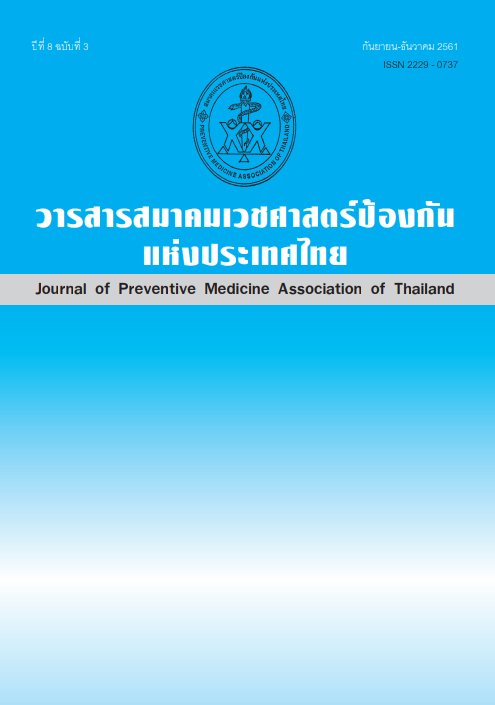Development of a Model for Tuberculosis Control Program with Directly Observed Treatment (DOT) in Huaithabthan District, Sisaket Province
Keywords:
Directly-Observed Treatment (DOT), Tuberculosis, HEAL MODEL, Community ParticipationAbstract
The purposes of this study were to develop a Directly-Observed Treatment (DOT) guide tuberculosis treatment model and to study the patient and the participant satisfaction of the Directly Observed Treatment for Tuberculosis (DOT) in Huaithabthan District, Sisaket Province. The total number of participant was 88 which included 37 tuberculosis patients and 51 caregivers. The data were collected through the tuberculosis patients’ handbook, quizzes and questionnaires. The data were analyzed by descriptive statistics, relative statistics t-test (dependent), t-test (Independent) and Fisher’s exact test. The result of this study demonstrated that HEAL MODEL would improve DOT including knowledge and understanding of caregivers (p<0.05), knowledge, self-efficacy and treatment plans implementation of tuberculosis patients (p<0.05). HEAL MODEL consisted of four components, H : Health Network Learning, E : Experiential Learning, A: Appreciative Participation Learning and L : Leader Learning. The success rate was 94.60 %. The satisfaction after development was found that the tuberculosis patients had a high level of satisfaction with tuberculosis services (=4.05) and the workers were satisfied with tuberculosis services at the high level (
=3.79). The conclusions of this study demonstrated that HEAL MODEL improved primary healthcare system, DOT recognition, DOT understanding and became community culture.
References
http://www.tbonline.info/posts/2016/3/31/description-tb-germ-mycobacteriumtuberculosis-1/
2. World Health Organization. Global tuberculosis report 2017. Geneva: World Health Organization; 2017.
3. สำนักโรคเอดส์วัณโรคและโรคติดต่อทางเพศสัมพันธ์ กรมควบคุมโรค. แนวทางการตรวจรักษาและป้องกัน การติดเชื้อเอชไอวีประเทศไทย. กรุงเทพฯ: โรงพิมพ์ชุมนุมสหกรณ์การเกษตรแห่งประเทศไทย; 2560.
4. สำนักวัณโรค กรมควบคุมโรค. แนวทางการควบคุมวัณโรคประเทศไทย พ.ศ. 2561. กรุงเทพฯ: อักษรกราฟฟิคแอนด์ดีไซน์; 2561.
5. พันธ์ชัย รัตนสุวรรณ. หลักการควบคุมวัณโรค ประสบการณ์ 10 ปี. นครศรีธรรมราช: สำนักงานป้องกันควบคุมโรคที่ 11 จังหวัดนครศรีธรรมราช; 2547.
6. พันธ์ชัย รัตนสุวรรณ, ชลดา ยวนแหล, ผกาวัลย์ แดหวา. การดำเนินงาน DOT (Directly-Observed Treatment) โดยมอบหมายการเป็นพี่เลี้ยงให้บุคคลอื่นที่ไม่ใช่ญาติ: รูปแบบของศูนย์วัณโรค เขต 11 นครศรีธรรมราช ปีงบประมาณ 2542-2543. สงขลานครินทร์เวชสาร 2545;20:69-78.
7. สมัญญา มุขอาษา. การศึกษาผลของโปรแกรมสร้างเสริมสุขภาพโดยการประยุกต์ทฤษฎีการสร้างพลังอำนาจในผู้ป่วยวัณโรคปอดเสมหะบวกรายใหม่. [วิทยานิพนธ์ปริญญาสาธารณสุขศาสตรมหาบัณฑิต]. ปทุมธานี: มหาวิทยาลัยธรรมศาสตร์; 2558.
8. Gibson CH. The process of empowerment in mothers of chronically ill children. J Adv Nurs 1995;21:1201-10.
9. กิตติพัทธ์ เอี่ยมรอด. การพัฒนากลยุทธ์การดำเนินงานควบคุมวัณโรคในพื้นที่จังหวัดตาก. วารสารสาธารณสุขมหาวิทยาลัยบูรพา 2558;10:1-14.
10. ผกายดาว พรหมสุรีย์. การเพิ่มอัตราการรักษาหายของผู้ป่วยวัณโรคในโรงพยาบาลน้ำยืน จังหวัดอุบลราชธานี. วารสารวิชาการสาธารณสุข 2557;23:181-4.
Downloads
Published
How to Cite
Issue
Section
License
บทความที่ลงพิมพ์ในวารสารเวชศาสตร์ป้องกันแห่งประเทศไทย ถือเป็นผลงานวิชาการ งานวิจัย วิเคราะห์ วิจารณ์ เป็นความเห็นส่วนตัวของผู้นิพนธ์ กองบรรณาธิการไม่จำเป็นต้องเห็นด้วยเสมอไปและผู้นิพนธ์จะต้องรับผิดชอบต่อบทความของตนเอง






